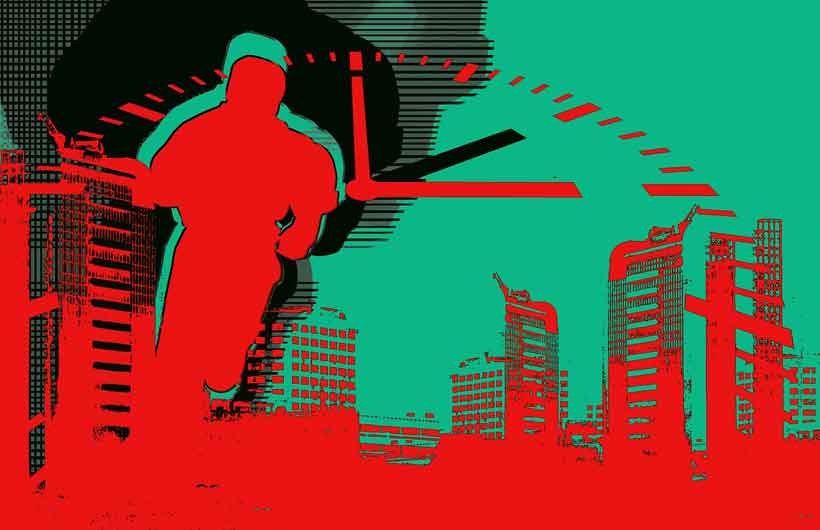I may get commissions for purchases made through links in this post.

The life of the freelancer, internet entrepreneur, work at home employee, and the location independent is a bliss.
You get to wake up whenever you want, work from home, and leisurely get to work. Being your own boss is amazing and less stressful. You don’t know why you didn’t choose to live this life sooner.
In reality things are more complicated.
Often you are working more hours and have a hard time making a clear distinction between work and your time off. You’re working your ass off while wondering, couldn’t I get results faster?
If this describes your current lifestyle then it’s time to make some serious changes. Working online does have its perks, but there is a certain level of discipline that you must have to make this an efficient and profitable venture.
To make the most of your solo work situation it’s best to work smarter and not harder. These time management strategies help you do that. When your productivity goes up you can convince your boss to value performance over presence.
Work Smarter, Not Harder: 18 Tips on Making More While Doing Less
1. Know Your Goals
What is it that you want to accomplish? This is the question you have to answer before beginning to work. Working aimlessly will get you nowhere fast.
Not only will you be directionless, but you will lose motivation because you are unsure of what you are working towards. If you have a clear picture of what your goals are it will make it much easier to focus and get work done more efficiently.
The other way round, if you don’t exactly know your goals you can’t stop doing stuff that doesn’t help you reach those goals.
“Goals are dreams with a deadline.” — Tony Robbins
2. Focus like laser beam
Focus. Focus. Focus. Do one thing and one thing only. Which one? The thing you do best. Outsource the rest. It’s easier said than done, but once you tap into it most everything falls into place.
This is the trait that all successful business leaders possess and it is absolutely essential if you want to make more while doing less work. Do not multi-task. It does not work. In fact, research shows that ‘cognitive losses from multitasking are even greater than the cognitive losses from pot‑smoking’. Do your best at what you are doing right now. Be in the moment. Focus on the process. This involvement enhances your creativity and increases your happiness.
Warren Buffet focused on investing (and how to keep the money earned). Steve Jobs focused on making a better personal computer (by reducing complexity and boosting user experience).
Work when you’re working. Turn off background noise, Facebook, Skype, and Whatsapp. No excuses, no distractions. Take this very seriously. When work-related distractions come up, such as ‘I need to email that Elance designer back’, write it on your to do list that you keep at hand.
Lacking focus makes it difficult to zero in on executing your goals and without this, you are in for a serious amount of wasted time and money.
3. Sharpen your saw
Razor-sharp concentration works only so well as the quality of your tools. Don’t use rusty tools. The old anecdote of two lumberjacks in a tree-cutting contest explains this perfectly.
One of them immediately picked up the first axe he lay his eyes on and ran into the woods chopping trees frantically. His axe turned out rusty. The other lumberjack took his time to sharpen his axe until the end of the contest was near. He then calmly walked up and felled the biggest tree, winning the contest.
The moral? Preparation and using the right tools is key.
Tools can be both software, hardware as well as other people you delegate tasks too. Others often have sharper tools for certain tasks. They are specialists. While you focus on your specialty you can master your craft while you hire others for their skills to save time and get more done.
4. Create a Plan with Manageable Tasks
Once you’ve developed the focus you need (if this is something you’re passionate about you’ll find it’s not so hard) it’s time to make a plan.
Call it old fashioned, but creating one can continue to keep you focused on meeting your goals. As a former project manager, I found that breaking down goals into tinier more manageable tasks can keep you super motivated.
There is a lot of satisfaction in checking off these small tasks and in no time you’ll find you’ve reached your goal.
5. Set Deadlines and Stick to Them
Making a plan with manageable tasks is great, but mapping out this plan isn’t where the work stops. You have to actually execute them, and you have to know when things need to be completed.
Take the time to set firm and realistic deadlines that will keep you motivated and on target with meeting your larger end goal. In addition to this, take the time to figure out which tasks are dependent on each other.
Understanding this will help you set reachable and realistic deadlines for all tasks involved.
6. Use the 80/20 Rule
The 80/20 rule can be applied to most things in your life. This rule, also known as the Pareto principle, states that 80% of effects come from 20% of causes. In other words, a small portion of things will affect the majority of outcomes.
Because of this, in your work life you have to prioritize how you tackle tasks. Eliminate the 80% of unproductive work that doesn’t affect a much larger bottom line and instead focus on the 20% that does.
Cut out the excess. It’s just that simple.
7. Use the Law of Diminishing Marginal Quality
This law similar to the law of diminishing utility refers to the rise and then decline of the success of your work with each additional “unit” of invested work effort.
This means that while you may continue to reap some benefit of extra time invested on a task, it becomes less and less valuable with the additional amount of time you spend on it.
The best way to determine how much energy to spend on a given task is to track your time.
8. Track Your Time
Tracking your time may not be the most fun activity, but it can be a very beneficial one. Once you start this practice you’ll begin to observe patterns in your work behavior that can help you structure your day.
You may find that you’re more productive earlier on in the day and tasks take a shorter amount of time to accomplish then, than later on in the day.
You might also find that spending less amount of time on a task may yield the same or comparable results than spending more time on it.
A quick example: let’s say you spend a lot of your time invoicing. Maybe you weren’t fully aware of how big of a chunk of your time this takes until you started tracking your time. Now you realize, that if you’d outsource it, someone else can do it faster so you can focus on your core tasks.
9. Work in bursts
The immensely popular high intensity interval training (HIIT) works wonders for staying lean. Its magic lies in the fact that it causes you to keep you burning fat even after you leave the gym. Working in intensely for a limited period of time gains you a similar effect. It doesn’t help you shed belly flab but it brings you something else.
Work with complete focus. Then stop and rest completely. This resting period is when creativity sparks. Your best ideas come to mind. Jot them down but respect the resting period.
Besides genius ideas sprouting in your mind, this tactic will help you accomplish more than working for days on end, getting more distracted and tired. Make sure to work in bursts on micro level, work slowly and consistently on macro level.
10. Manage your energy
This one’s a biggie, especially if you have a lot of willpower. Willpower can backfire when you keep going because you want to get things done but forget to step back and get your rest.
I know because for years, I’ve been working like a headless chicken. I thought, the more I do, the more results I get. Boy I was wrong. Not only is this approach far from the most effective way of working, it also drains your energy.
It gradually but surely turns you from a headless chicken into a boneless chicken (picture Cousin Boneless from the Cow and Chicken cartoon). Trust me, I’ve had times my energy levels were so low, I couldn’t raise up from bed to reach my glass of water on the night stand. During the day.
Take time to step back. During the day, in the evening and in weekends. Get up from your desk, go out or to another room.
Nowadays, in between tasks, I like to lie in my hammock and meditate (the swinging undulation offers a wondrous way to relax and improves concentration).
[bctt tweet=”Productivity tip: Recharge. Take rest and fun seriously. Doing too much is counterproductive.” via=”no”]
11. Use Parkinson’s Law
Parkinson’s Law is the truism that “work will fill the time available for its completion.” In other words, the more time you give yourself, the more time a certain task will take.
The stricter the deadline, the more you will get done. It’s all about getting things done instead of doing the work.
Don’t allocate 30 minutes for email each morning. Force yourself to do it in 5 minutes by setting a timer. You will be much more efficient in determining what’s essential and what can be skipped.
Divide huge projects up into smaller pieces. Set out to complete those pieces, rather than working on the project aimlessly.
12. Automate and Outsource Everything You Can
Now that you understand some of the principles explained above you know that dedicating your time to all of the tiny details of business may not be the best use of your time.
You want to be able to manage these processes and focus on the bigger picture. One way to do this is by automating things.
That is what technology is for and there is no use in spending that extra energy when a computer can do it for you. For things that need a human eye and care, outsource it or hire an assistant.
13. Hire People You Can Trust
Great, so you’ve outsourced some of the tedious work to some people. The trick here is to step back and avoid the temptation to micromanage.
This can be especially difficult if you’re really attached to some of the tasks they’re doing and you think you know how to do it exactly right.
Take the time to hire people you can trust, train them, and step away. Let them do their jobs so you can do yours. This will save you from uneasiness and from redundant rework.
14. Use the Pay Certainty Technique
Coined by Ramit Sethi, author of the New York Times bestseller, I Will Teach You To Be Rich, the basically urges you to focus on ability and willingness to pay. Focus on clients that both have the financial means to pay for your services as well as the willingness to pay.
It’s a simple principle but essential, and often overlooked. Narrow down your desired client base. Cater to specific needs in your niche. Your clients will benefit from a much more valueable service and you are able to charge more.
A female senior executive who wants to give her grand daughter piano lessons is a better target group then a 18 year old college student.

15. Charge More For Your Services
When you first start out you may be more easily persuaded to take on lower rates for your work to gather experience. However, if you’re a more seasoned professional it’s important to know your worth.
You may be underselling yourself and missing out on a lot of money. Increase your rate for services to maximize your work value, but be prepared to have your sales pitch ready to persuade existing and potential clients.
16. Take advantage of the Pomodoro technique
The Pomodoro technique recommends to work 25 minutes and then pause for 5 minutes. You can extend these numbers, for instance work for 2 hours on end and then take 30 minutes off. This Shaolin monk recommends to pause for 10 minutes after every 40 minutes.
This is a more practical approach for if you don’t want to disturb your ‘flow’. When you’re in the zone, the last thing you’ll want is to pause, you’re just getting on steam.
Keep in mind though that, simply put, more breaks equals more productivity.
Do systematically cut up your tasks into chunks though. It prevents going on for too long, helps you recharge, and by taking steps back provides you with a helicopter view of what you’re doing.
This prevents making mistakes and increases creativity.
17. Avoid Demanding Clients
We are all familiar with the saying, “The customer is always right.” But in your online business, listening to the wrong customers can be a drain on your money and your time.
Think critically about how much return you’re getting on your investment of time on their work. It may not be worth keeping diva clients when you can service more low key clients – which can translate to more money.
Remember time is just as valuable as money.
18. Don’t Reinvent the Wheel
While there is a certain amount of fun in starting a project from scratch it can be inefficient especially if you have a lot of similar ones. Why reinvent the wheel if you have a template or method that you can use from past projects.
Take the foundational elements of these projects and use them to help guide you through the process of new ones. This will free up more time for you to take on other projects.
19. Stop Procrastinating
We all procrastinate to some extent. Whether it’s checking social media accounts, telling yourself you need to have more inspiration, or focusing on the 80% that’s less important. Be aware of the fact that you are stalling. Give yourself a kick in the pants. Visualize your goals. It helps you stay motivated.
“Why is this compelling for you? What will you gain by achieving it? What would you miss out on if you didn’t achieve it? Are these reasons strong enough to get you to actually follow through? If not, either come up with a better goal or better reasons.” – Tony Robbins from Awaken The Giant Within.
With these 18 tips you’ll be on your way to working smarter (not harder) and making the money you want faster.
Need more tips?
Goals are helpful but what really gets your flow going is adopting a system. By focusing on the process of the work instead of future goals you are more in the moment.
You are enjoying what you do, have more energy, and feel more relaxed about it. A book that really helped me install a system is Getting Things Done: The Art of Stress-Free Productivity.
Want to earn money on the side so you can eventually quit your day job?
Read this easy to use guide on how to start a location independent business.
Over to you. Which productivity hacks do you use?
Share them below.
Image: Pixabay.



















Wow, awesome weblog layout! How long have you been blogging
for? you made blogging look easy. The overall look of your site is wonderful, as smartly as the content!